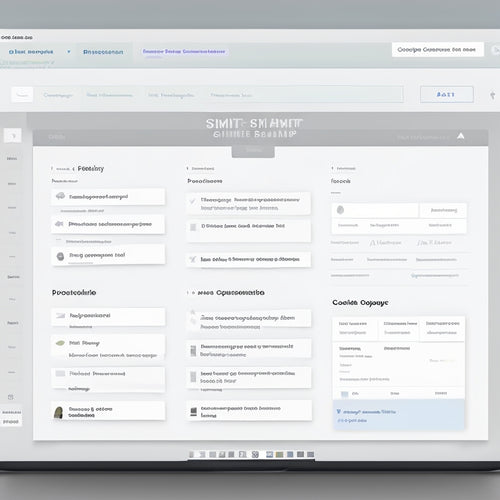
Overcoming Operational Hurdles in Online Store Management
Share
You're likely no stranger to the frustrations of operational hurdles in your online store, where a single snag in fulfillment, inventory management, or payment processing can bring your business to a grinding halt. To overcome these hurdles, you'll need to identify and address bottlenecks in your fulfillment process, optimize inventory management, and streamline order processing. You'll also need to develop strategies for dealing with supply chain disruptions, managing multiple sales channels, and overcoming payment processing issues. By implementing these strategies and simplifying your return and refund processes, you'll be able to minimize disruptions and stay ahead of the competition - and that's just the starting point for transforming your online store's operations.
Key Takeaways
• Identify and optimize operational bottlenecks in fulfillment, inventory management, and order processing to improve efficiency and reduce errors.
• Develop strategies to mitigate supply chain disruptions, including identifying alternative sourcing options and diversifying transportation networks.
• Streamline order processing and payment processing by implementing automation solutions, reducing manual errors, and utilizing fraud prevention techniques.
• Implement effective inventory management practices, including accurate stock tracking, real-time updates, and sufficient stock alerts to prevent overselling and shortages.
• Establish clear return and refund policies, providing easy return initiation processes to boost customer satisfaction and reduce disputes.
Identifying Bottlenecks in Fulfillment
When managing an online store, you need to pinpoint the exact stages in your fulfillment process where orders are getting stuck, taking too long, or costing too much, as these bottlenecks can greatly impact your customer satisfaction and bottom line.
To identify these bottlenecks, you must analyze your entire fulfillment process, from receiving orders to shipping products. Look for areas where orders are piling up, and investigate the root causes of these delays.
Optimizing your warehouse layout can help alleviate congestion and reduce travel time for your staff. By streamlining your warehouse layout, you can increase efficiency and reduce labor costs. Implementing automation technology, such as conveyor belts or automated sorting systems, can also help speed up your fulfillment process and reduce errors.
Additionally, automation can help you process orders more accurately and efficiently, freeing up staff to focus on higher-value tasks. By identifying and addressing these bottlenecks, you can improve your overall fulfillment process, reduce costs, and increase customer satisfaction.
Inventory Management Nightmares
Effective inventory management is crucial to the success of your online store, but it can quickly turn into a nightmare if you're not accurately tracking stock levels, leading to overselling, stockouts, and disappointed customers. When you're not on top of your inventory, you risk facing stock shortages, which can lead to lost sales and revenue. On the other hand, overstocking can result in unnecessary storage costs and waste.
| Common Inventory Management Issues | Consequences |
|---|---|
| Inaccurate stock tracking | Overselling and stockouts |
| Failure to account for product variations | Product mismanagement |
| Insufficient stock alerts | Stock shortages and lost sales |
| Inadequate storage and organization | Overstocking and waste |
| Lack of real-time inventory updates | Delays and inefficiencies |
To avoid these inventory management nightmares, you need to have a system in place to track your stock levels accurately, receive timely alerts when items are running low, and make informed decisions about restocking and product management. By staying on top of your inventory, you can guarantee that your online store runs smoothly, and your customers remain happy and loyal.
Streamlining Order Processing Chaos
How do you currently handle the influx of orders pouring into your online store, and are you confident that each one is being processed efficiently and accurately? If you're like many e-commerce businesses, you're likely struggling to keep up with the volume, leading to delays, errors, and frustrated customers.
It's time to streamline your order processing chaos. Automation solutions can be a game-changer here. By implementing automated workflows, you can reduce manual errors, free up staff to focus on higher-value tasks, and get orders out the door faster.
For instance, you can set up automated email notifications to keep customers informed about their order status, reducing the likelihood of anxious calls and emails to your customer service team.
Effective customer communication is key to building trust and loyalty. By leveraging automation solutions, you can make sure that your customers receive timely updates, accurate tracking information, and personalized communication that makes them feel valued.
This not only improves the customer experience but also lessens the burden on your support team, allowing them to focus on resolving complex issues and providing exceptional service.
Dealing With Supply Chain Disruptions
You've optimized your order processing, but supply chain disruptions can still bring your online store to a grinding halt, and it's essential that you're prepared to mitigate their impact.
Production delays, for instance, can be devastating, causing stockouts and lost sales. To minimize the damage, identify sourcing alternatives that can fill the gap. This might involve partnering with new vendors or negotiating with existing ones to expedite delivery.
Effective vendor communication is vital in times of disruption. Establish open lines of communication to stay informed about potential issues and work together to find solutions.
Transportation challenges, such as weather-related delays or carrier disruptions, can also wreak havoc on your supply chain. Develop contingency plans, like diversifying your transportation network or investing in logistics software, to reduce the risk of these disruptions.
Managing Multiple Sales Channels
As your online store expands, juggling multiple sales channels - from your website and social media to marketplaces and physical stores - becomes a complex balancing act that demands careful coordination to maintain a unified brand experience.
You need to ensure smooth integration across all channels, guaranteeing consistent product offerings, pricing, and messaging. Channel optimization is key, as you must identify which channels drive the most sales and allocate resources accordingly.
Effective sales tracking helps you monitor performance and make data-driven decisions. To maximize reach, you'll need to develop targeted marketing strategies based on customer segmentation. This involves analyzing buyer personas, purchasing habits, and preferences to tailor your approach.
Overcoming Payment Processing Issues
When processing payments online, you're likely to encounter a myriad of issues, from failed transactions and declined credit cards to security concerns and integration glitches, that can quickly erode customer trust and lead to lost sales.
To overcome these hurdles, implementing robust payment gateway integration that guarantees seamless transactions is crucial. This can be achieved by partnering with a reliable payment service provider that offers advanced fraud prevention techniques, such as machine learning-based fraud detection and 3D Secure authentication.
Additionally, consider implementing tokenization, which substitutes sensitive credit card information with a unique token, reducing the risk of data breaches. By investing in a secure and reliable payment processing system, you can minimize the risk of payment processing issues and ensure a smooth checkout experience for your customers.
This, in turn, can lead to increased customer satisfaction, loyalty, and ultimately, revenue growth. By prioritizing payment processing issues, you can focus on what matters most – growing your online business.
Simplifying Return and Refund Processes
By streamlining payment processing, you can now turn your attention to another critical aspect of online store management: refining your return and refund processes to reduce customer frustration and minimize revenue loss.
A well-designed return policy is essential for maintaining customer satisfaction, as it shows that you're committed to providing a hassle-free shopping experience. Start by clearly outlining your return policies on your website, including the timeframe for returns, refund methods, and any restocking fees.
Make it easy for customers to initiate returns by providing a straightforward process, such as a return merchandise authorization (RMA) system or a simple online form. Implementing a fair and efficient return process won't only boost customer satisfaction but also reduce the likelihood of disputes and chargebacks.
Frequently Asked Questions
How Do I Handle High-Volume Sales During Peak Holiday Seasons?
'When the floodgates open, you'll need to be prepared. To handle high-volume sales, you're juggling inventory management and staffing strategies to guarantee customer service and fulfillment optimization, all while keeping your cool under pressure.'
What Tools Can I Use to Measure and Analyze Operational Efficiency?
You'll want to leverage data analytics tools to measure operational efficiency, tracking key performance indicators like order fulfillment rates and inventory turnover. Consider implementing efficiency optimization software to automate processes and streamline workflows.
Can I Automate Tasks Without Sacrificing Customer Personalization?
You're concerned that automation will compromise customer personalization, but you can strike a balance by implementing automated workflows that enhance the customer experience while still allowing for tailored interactions, ensuring efficiency without sacrificing personal touch.
How Do I Maintain Transparency in My Online Store's Operations?
You maintain transparency in your online store's operations by implementing customer feedback and enhancing communication through regular updates, clear policies, and open channels, ensuring trust and loyalty with your customers.
What Strategies Can I Use to Reduce Operational Costs Without Sacrificing Quality?
You streamline logistics, renegotiate supplier contracts, and implement cost-saving techniques like batch processing, ensuring quality assurance while optimizing efficiency and improving processes to reduce operational costs without sacrificing excellence.
Related Posts
-

Does Shopify Automatically Submit a Sitemap
This article examines the functionality of Shopify in relation to automatic sitemap submission. The focus is on the ...
-

Should I Add Reviews to My Shopify Store
The inclusion of customer reviews in e-commerce platforms has become a topic of interest and debate among Shopify st...
-

Top Shopify Popup Apps for Growing Your Business
This article provides an overview of the top Shopify popup apps available for growing businesses. Popups are commonl...


